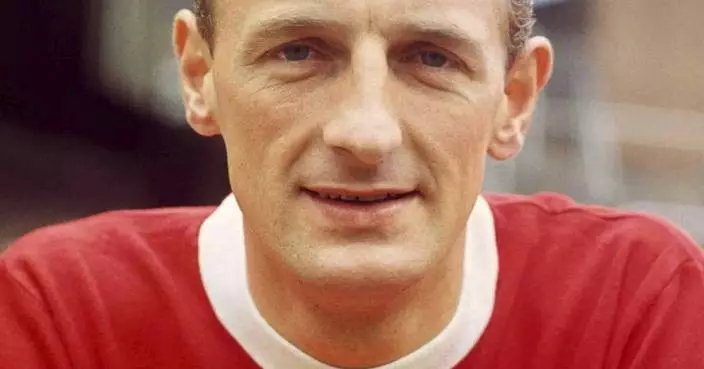Shipments of Russian liquified natural gas to France more than doubled the first half of this year, according to new analyses of trade data, at a time when Europe has tried to pull back from energy purchases that help finance the Kremlin's invasion of Ukraine.
Europe has restricted oil imports from Russia, but natural gas is still allowed. And while companies in France are importing the most, one analysis found EU countries overall imported 7% more Russian LNG, natural gas that has been chilled and liquified for easier ocean transport, in the first half of this year compared to the same period a year ago.
Oleh Savytskyi, a founding member of nonprofit Razom We Stand, which campaigns for tougher sanctions on Russian fossil fuels, said the EU’s goal of phasing out all Russian fossil fuels by 2027 was “appallingly off track.” He said countries buying Russian LNG are sabotaging the continent’s energy transition and contributing billions to Russia’s war effort.
European governments have said banning Russian gas imports entirely would send energy and heating bills skyrocketing and industrial users of gas would suffer, too.
The analysis first came from the Institute for Energy Economics and Financial Analysis (IEEFA), a U.S. nonprofit with a goal of speeding the world’s transition to more sustainable energy. IEEFA examined data from Kpler, a shipping tracker, and ICIS, a commodity data provider, both of which also provided their own analysis.
The institute said companies imported almost 4.4 billion cubic meters of Russian LNG to France in the first half of this year, compared to more than 2 billion cubic meters in the same period a year ago. The next biggest importers, Spain and Belgium, saw a 1% rise and a 16% decline respectively, IEEFA said.
TotalEnergies, the French energy giant that accounted for the largest share of the imports in a list of cargoes between January and June seen by The Associated Press, said it was bound by contracts signed before Russia's Ukraine invasion. And France's Finance and Economy Ministry told the AP that Houthi rebel attacks on ships moving through the Suez Canal have forced a reshaping of LNG imports — gas from the Middle East can no longer get easily to Europe, while Russia's route from the Arctic has been unaffected.
The ministry noted that France is one of Europe's main entry points for LNG. France and Spain, with seven each, have the most LNG terminals in Europe.
At the same time France was importing more Russian LNG, it was importing less from other suppliers including the United States, Angola, Cameroon, Egypt and Nigeria — an amount approaching the jump in Russian LNG, according to the analysis. None of those other countries' LNG exports were affected by the Red Sea attacks.
Pricing data for Russian LNG isn't public. But it typically sells for a small discount because some buyers don't want it, said Jason Feer, global head of business intelligence at energy consultants Poten and Partners.
The extra gas isn’t being used by French homes or industry. Demand in France fell 9% in the first half of this year compared to last year. Meanwhile, France’s export of gas by pipeline to Belgium rose almost 10% in the first six months, according to Kpler. It’s not possible to tell how much of that export was Russian LNG.
“What that tells you is people are making money off this trade,” said Feer.
Russia’s biggest LNG project is in the Arctic Circle’s Yamal Peninsula, a joint venture with TotalEnergies, which owns 20%. Under a contract signed in 2018, TotalEnergies is committed to buying 4 million tons of gas from there annually.
TotalEnergies said by email that it was legally bound to honor its contracts and will do so “as long as Europeans governments deem Russian gas necessary for the European Union’s security of supply.”
Only if new sanctions were imposed could the purchases be suspended, it said. TotalEnergies said its imports of Russian LNG into Europe had actually fallen over the period studied.
An EU Commission spokesman said imports of Russian gas fell considerably between 2021 and 2023.
A temporary volume increase “does not put into question the EU achievements over the past two years,” spokesman Adalbert Jahnz said. “We have diversified our imports and the bulk of the necessary gas is supplied by reliable partners, such as Norway and the US.”
But Razom We Stand’s Savytskyi called for the EU to implement a full embargo on the commodity. TotalEnergies “should not have a free pass to keep Europe hooked on Russian gas,” he said.
The Associated Press’ climate and environmental coverage receives financial support from multiple private foundations. AP is solely responsible for all content. Find AP’s standards for working with philanthropies, a list of supporters and funded coverage areas at AP.org.

FILE - The tanker Sun Arrows loads its cargo of liquefied natural gas from the Sakhalin-2 project in the port of Prigorodnoye, Russia, on Friday, Oct. 29, 2021. Shipments of Russian liquified natural gas to France more than doubled the first half of this year, according to new analyses of trade data, at a time when Europe has tried to pull back from energy purchases that help finance the Kremlin's invasion of Ukraine. (AP Photo, File)
LONDON (AP) — A car-ramming at a Christmas market in Germany, which police are treating as an attack, is the latest in a grim series of events in which vehicles have been used as deadly weapons.
There have been a spate of such attacks over the past decade, some committed by groups but most by individuals. The motives – where they could be established – have varied widely. Some were inspired by Islamic militant groups such as al-Qaida and ISIS, which encouraged followers to carry out low-cost, low-tech attacks with cars and trucks. Others have been linked to mental illness, far-right extremism and online misogyny.
What law-enforcement authorities term “vehicle as a weapon attacks” have reshaped cities around the world, as planners erect concrete barriers around public spaces and build anti-vehicle obstacles into new developments.
Here are some major vehicle attacks:
MAGDEBURG, Germany, Dec. 20. 2024 — At least five people are killed and more than 200 injured when a car slams into a Christmas market in eastern Germany. The suspect, who was arrested, is a 50-year-old doctor originally from Saudi Arabia who had expressed anti-Muslim views and support for the far-right AFD party.
ZHUHAI, China, Nov. 11, 2024 — A 62-year-old driver rams his car into people exercising at a sports complex in southern China, killing 35 people in the country’s deadliest mass slaying in years. Authorities said the perpetrator was upset about his divorce but offered few other details.
LONDON, Ontario, June 6, 2021 — Four members of a Muslim family die when an attacker hits them with a pickup truck while they are out for a walk, in what Canadian Prime Minister Justin Trudeau calls “a terrorist attack, motivated by hatred.” White nationalist attacker Nathaniel Veltman was sentenced to life in prison.
TORONTO, April 23, 2018 — A 25-year-old Canadian man, Alek Minassian, drives a rented van into mostly female pedestrians on Yonge St., the main thoroughfare in Toronto, killing 10 people and injuring 16. Minassian told police he belonged to the online “incel” community of sexually frustrated men.
NEW YORK, Oct. 31, 2017 — Sayfullo Saipov, an Islamic extremist from Uzbekistan, drives a pickup truck onto a popular New York City bike path, killing eight.
BARCELONA, Aug. 17, 2017 — A man driving a van slams into people on the Spanish city’s crowded Las Ramblas boulevard, killing 14 and injuring many others. Several members of the same cell carry out a similar vehicle attack in the nearby resort town of Cambrils before they are shot dead by police. The Islamic State group claimed responsibility.
CHARLOTTESVILLE, Virginia, Aug. 12, 2017 — During a “Unite the Right” rally, white supremacist James Alex Fields Jr. intentionally drives his car into a crowd of counter-protesters, killing one woman and injuring dozens of people.
LONDON: March 22, 2017 — British man Khalid Masood rams an SUV into people on Westminster Bridge, killing four, before stabbing to death a policeman guarding the Houses of Parliament nearby. He is shot dead. June 3, 2017 — three attackers drive a van at pedestrians on London Bridge before stabbing people in nearby Borough Market. Eight people are killed and the attackers shot dead by police. June 19, 2017 — Darren Osborne, a man radicalized by far-right ideas, drives a van at worshippers outside a mosque in London’s Finsbury Park area, killing one man and injuring 15 people.
MELBOURNE, Australia, Jan 20, 2017 – Six people are killed and more than 30 injured when a car hits lunchtime crowds at a pedestrian mall in Australia’s second-largest city. Perpetrator James Gargasoulas is found to have been in a state of drug-induced psychosis.
BERLIN, December 19, 2016 — Anis Amri, a rejected asylum-seeker from Tunisia, plows a hijacked truck into a Christmas market in the German capital, killing 13 people and injuring dozens. The attacker is killed days later in a shootout in Italy.
NICE, France, July 14, 2016 — Tunisian-born French resident Mohamed Lahouaiej-Bouhlel drives a rented truck for more than a mile (almost 2 kilometers) along a packed seaside promenade in the French Riviera resort on the Bastille Day holiday, killing 86 people in the deadliest attack of its kind.
APELDOORN, Netherlands, April 28, 2009 – Former security guard Karst Tates drives a car into parade spectators in an attempt to hit an open-topped bus carrying members of the Dutch royal family. Six people are killed and Tates dies of injuries the next day, leaving his full motive a mystery.
CHAPEL HILL, North Carolina, March 3, 2006 — University of North Carolina graduate Mohammed Taheri-Azar drives an SUV into a crowd at the university, lightly injuring nine people, in a self-professed bid to avenge Muslim deaths overseas.

FILE - Injured people are treated in Barcelona, Spain, Thursday, Aug. 17, 2017 after a white van jumped the sidewalk in the historic Las Ramblas district, crashing into a summer crowd of residents and tourists. (AP Photo/Oriol Duran, File)

FILE - In this April 23, 2018, file photo, police stand near a damaged van after a van mounted a sidewalk crashing into pedestrians in Toronto. (Aaron Vincent Elkaim/The Canadian Press via AP, File)

FILE - Forensic officers move the van at Finsbury Park in north London, where a vehicle struck pedestrians in north London Monday, June 19, 2017. (AP Photo/Frank Augstein, File)

FILE - In this Dec. 20, 2016 file photo the trailer of a truck stands beside destroyed Christmas market huts in Berlin, Germany. (AP Photo/Markus Schreiber, file)

FILE - In this July 14, 2016 file photo, authorities investigate a truck after it plowed through Bastille Day revelers in the French resort city of Nice, France, killing 86 people. (Sasha Goldsmith via AP, File)

FILE - In this Wednesday, March 22, 2017 file photo, police secure the area on the south side of Westminster Bridge close to the Houses of Parliament in London. (AP Photo/Matt Dunham, File)

FILE - People fly into the air as a vehicle drives into a group of protesters demonstrating against a white nationalist rally in Charlottesville, Va., Saturday, Aug. 12, 2017. (Ryan M. Kelly/The Daily Progress via AP, File)

FILE - In this Dec. 20, 2016 file photo Christmas decoration sticks in the smashed window of the cabin of a truck which ran into a crowded Christmas market Monday evening killing several people in Berlin, Germany. (AP Photo/Markus Schreiber, file)


















